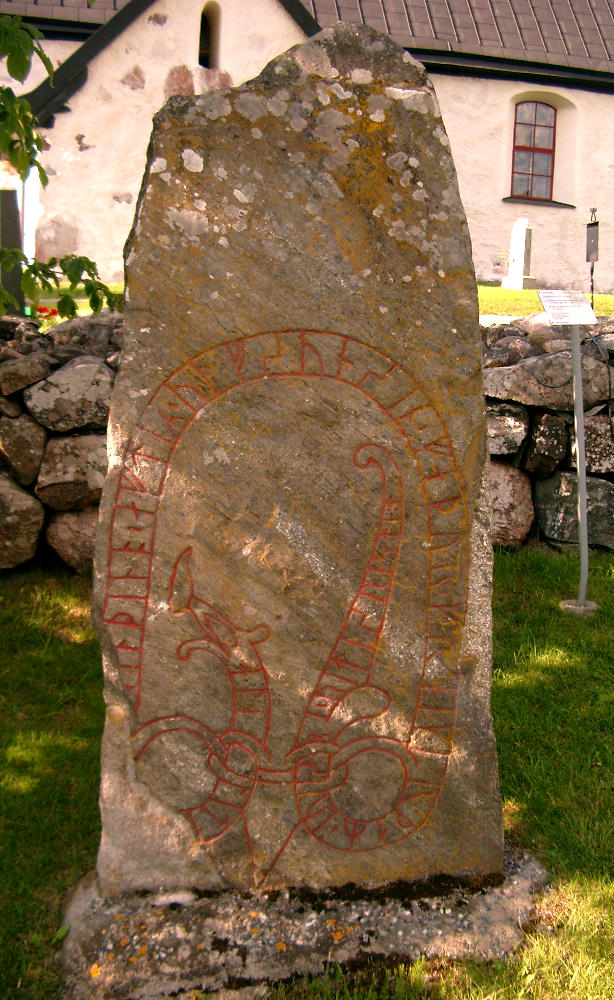Frögärd I Ösby on:
[Wikipedia]
[Google]
[Amazon]
150px, U 194 in Väsby has been erroneously attributed to Frögärd. Frögärd Ulvsdotter i Ösby (11th century) was a Swedish Norse woman. She was according to a common misconception believed to be a
Frögärd Ulvsdotter i Ösby (11th century) was a Swedish Norse woman. She was according to a common misconception believed to be a
Svenska runristare
(Swedish runmasters) (1925), p. 13 erroneous interpretation of runestone U 203. As early as 1943,
''The Viking-age Rune-stones: Custom and Commemoration in Early Medieval Scandinavia.''
Oxford University Press. p. 58 n., 65. . Both U 194 and U 203 are carved by
 Frögärd Ulvsdotter i Ösby (11th century) was a Swedish Norse woman. She was according to a common misconception believed to be a
Frögärd Ulvsdotter i Ösby (11th century) was a Swedish Norse woman. She was according to a common misconception believed to be a Viking Age
The Viking Age () was the period during the Middle Ages when Norsemen known as Vikings undertook large-scale raiding, colonizing, conquest, and trading throughout Europe and reached North America. It followed the Migration Period and the Ger ...
female runemaster
A runemaster or runecarver is a specialist in making runestones.
Description
More than 100 names of runemasters are known from Viking Age Sweden with most of them from 11th-century eastern Svealand.The article ''Runristare'' in ''Nationalencyklo ...
. This notion is based on Erik Brate
Erik Brate (13 June 1857 – 11 April 1924) was a Swedish linguist and runologist.
Biography
Brate was born in 1857 in Norberg, Västmanland County. In 1887 he married the Swedish painter Fanny Brate, née Ekbom (1861-1940). They had four ...
's Erik Brate
Erik Brate (13 June 1857 – 11 April 1924) was a Swedish linguist and runologist.
Biography
Brate was born in 1857 in Norberg, Västmanland County. In 1887 he married the Swedish painter Fanny Brate, née Ekbom (1861-1940). They had four ...
Svenska runristare
(Swedish runmasters) (1925), p. 13 erroneous interpretation of runestone U 203. As early as 1943,
Elias Wessén
Elias Wessén (15 April 1889 – 30 January 1981) was a prominent Swedish linguist and a professor of Scandinavian languages at Stockholm University (1928–1956). In 1947, he was honoured with one of the 18 seats at the Swedish Academy (which f ...
convincingly demonstrated that the sequence in question cannot be read as a carver's signature. Also, the place name uisby should be read ''Väsby'' rather than ''Ösby''.
U 203 was raised by Ale (or Alle) in memory of his son Ulv, “father to Frögärd in Väsby”. Ale (Alle) is also responsible for runestone U 194, which he raised in memory of himself while he was still alive. According to this inscription, Ale (Alle) received a share of Canute the Great
Cnut (; ang, Cnut cyning; non, Knútr inn ríki ; or , no, Knut den mektige, sv, Knut den Store. died 12 November 1035), also known as Cnut the Great and Canute, was King of England from 1016, King of Denmark from 1018, and King of Norway ...
’s Danegeld
Danegeld (; "Danish tax", literally "Dane yield" or tribute) was a tax raised to pay tribute or protection money to the Viking raiders to save a land from being ravaged. It was called the ''geld'' or ''gafol'' in eleventh-century sources. It ...
in 1017. Thus, Frögärd was probably a member of a wealthy family and the only beneficiary of her father's and grandfather's inheritance. Birgit Sawyer suggests that Ale's (Alle's) purpose with U 203 could have been to take care of his underage granddaughter's inheritance.Birgit Sawyer (2000)''The Viking-age Rune-stones: Custom and Commemoration in Early Medieval Scandinavia.''
Oxford University Press. p. 58 n., 65. . Both U 194 and U 203 are carved by
Åsmund Kåresson
Åsmund Kåresson was a Viking Age runemaster who flourished during the first half of the 11th century in Uppland and Gästrikland, Sweden. The early Urnes style is represented in his art. pp. 197, 208–09.
Work
Most early medieval Scandinavians ...
.
An actual Swedish female Viking Age runemaster
A runemaster or runecarver is a specialist in making runestones.
Description
More than 100 names of runemasters are known from Viking Age Sweden with most of them from 11th-century eastern Svealand.The article ''Runristare'' in ''Nationalencyklo ...
was Gunnborga
Gunnborga (fl. 11th century), also known as ''Gunnborga den goda'' (literary: 'Gunnborga the Good'), was a Viking Age Swedish runemaster.Forntida kvinnor: jägare, vikingahustru, prästinna, Catharina Ingelman-Sundberg - 2004 - Strängvy
She was r ...
.
References
11th-century Swedish people Runemasters 11th-century deaths Year of birth unknown 11th-century Swedish women {{Sweden-artist-stub